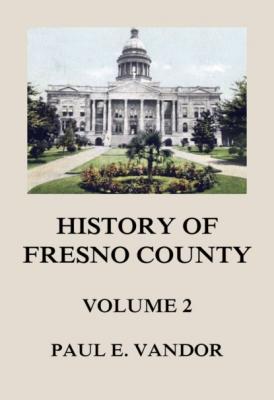ТОП просматриваемых книг сайта:
History of Fresno County, Vol. 2. Paul E. Vandor
Читать онлайн.Название History of Fresno County, Vol. 2
Год выпуска 0
isbn 9783849658991
Автор произведения Paul E. Vandor
Жанр Документальная литература
Издательство Bookwire
Murder of Policeman Van Meter
Policeman Harry S. Van Meter was murderously shot while on duty on the night of February 20, 1907, and died on the following day. He encountered a suspect at the corner of I and Inyo Streets. Three shots were fired by the night prowler and all took effect. Van Meter wearing a heavy overcoat was unable to open it to draw revolver to defend himself. One Ernest C. Sievers was arrested suspected of the murder but never prosecuted as the evidence proved insufficient. Van Meter twice identified him as his murderer, the last time on his death bed, but there was no corroboration save in a gray hat such as Van Meter stated the fellow, who had shot him, wore. Sievers claimed an alibi and that at the time of the shooting he was in a certain saloon. This was in part corroborated, but not positively as to the hour. The murder of the young policeman created such a sensation that a public money subscription was raised for the widow. He was a son of City Attorney E. S. Van Meter. Early in December 1909 came a story from Folsom penitentiary of the murderer of Van Meter in February 1907." One Mack Reed imprisoned under a life sentence claimed to be the murderer according to admissions to a cellmate. The latter drew the story from him, informed a guard and former resident of Fresno of the details, and the guard writing to the police and learning that no reward had been offered for the apprehension of the murderer related the confession on a visit to Fresno. The prisoner's confession was made four months before the official recital. No action was ever taken on the supposed confession. Reed is under sentence for a criminal assault upon his ten year old daughter in the fall of 1907. Ernest Sievers, the man that Van Meter had identified as his assailant, was tried for his life and acquitted and after liberation returned to his home in Missouri. Reed in his confession claimed to have shot Van Meter five times after having been detected in a burglary of dye works on South I Street. Escaping at the rear door he met the patrolman in the alley at Inyo Street at the spot where the shooting took place.
Watchman Murdered
There was an epidemic of night store burglaries during the fall and winter season of 1907. L. C. Smith, night watchman in the city business center, was found shot and killed on the morning of October 10 in the alley off Fresno Street alongside the Barton theater. He had evidently surprised a housebreaker and in the rencontre was murdered. The attempted burglary was of the Opera Bar at the back transom. Seven shots were fired in the alley flight of burglar or burglars in the direction of Merced Street. Three times was "Dad" Smith wounded in the right side, two shots high and the other low, all evidently from a large caliber revolver and at short range judging from the powder burns. No weapon was in the hand of the watchman when found dead, or near him. The murder was never cleared up.
Tax Defalcation
In December 1907 report was made to the supervisors in 141 typewritten pages covering an exhaustive investigation of the books of the county tax collector's office from January 1, 1899 to July 2, 1907 following discovery of defalcations by W. M. Walden, who was deputy and cashier under the administration of the late J. B. Hancock. The net balance found due was $2,130.14 with discovery of numerous errors and disbursements in a debit originally by the collector of a total of $4,141.77. Walden was indicted, pleaded guilty, sentenced and later liberated on probation. The peculations were in small sums and covered a long period. Discovery of them was made incidentally in examination of the collector's books in the auditor's office while working over them at night. In turning over the leaves a page of an account book was held up for better reading with the electric light behind it. This showed erasure with chemical fluid so that the spot was transparent. This excited suspicion and the volume being closer scrutinized against the light numerous other like erasures were discovered. A sensation followed that was at once taken before the grand jury for investigation with stated result. Walden was indicted July 9, 1907 for falsification of public records and pleading guilty October 4, was sentenced to the penitentiary at San Quentin for seven years.
Fifty Years for Highway Robbery
"Why didn't you bury me alive?" hissed back Julius Smith one day in December 1907 upon Judge H. Z. Austin's sentence of fifty years imprisonment at San Quentin after he had pleaded guilty to the charge of highway robbery. His accomplice had previously confessed and would have been used as state's evidence against Smith. The time was when highway robberies were epidemic. The sentences came under fierce criticism by the prison commissioners sitting as a board of pardon. The sentence was equivalent under the prison credit system for good behavior to twenty-nine years and

